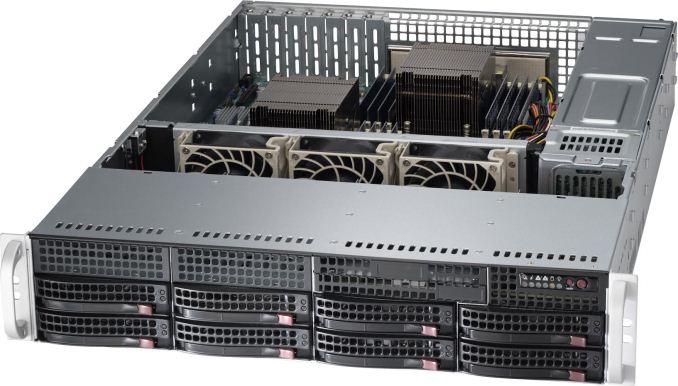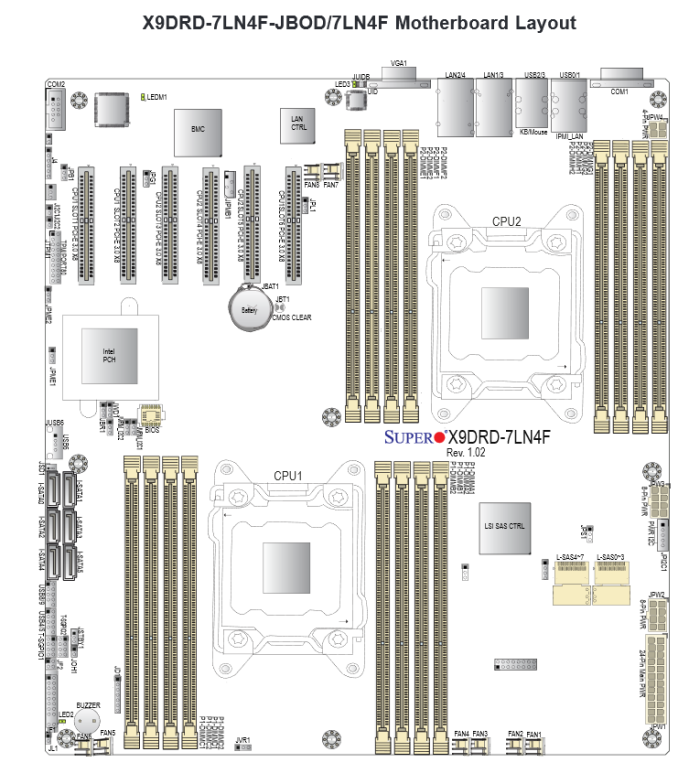Free Cooling: the Server Side of the Story
by Johan De Gelas on February 11, 2014 7:00 AM EST- Posted in
- Cloud Computing
- IT Computing
- Intel
- Xeon
- Ivy Bridge EP
- Supermicro
The Supermicro "PUE-Optimized" Server
We tested the Supermicro Superserver 6027R-73DARF. We chose this particular server for two main reasons: first, it is a 2U rackmount server (larger fans, better airflow) and secondly, it was the only PUE optimized server with 16 DIMMs. Many applications are more memory capacity than CPU limited, so a 16 DIMM server is more desirable to most of our readers than an 8 DIMM server.
On the outside, it looks like most other Supermicro servers, with the exception that the upper third of the front is left open for better airflow. This in contrast with some Supermicro servers where the upper third is filled with disk bays.
This superserver has a few features to ensure that it can can cope with higher temperatures without a huge increase in energy consumption. First of all, it has an 80 Plus Platinum power supply. A platinum PSU is not exceptional anymore: almost every server vendors offers at least the slightly less efficient 80 Plus Gold PSUs. Platinum PSUs are the standard for new servers, DELL and Supermicro even started offering 80 Plus Titanium PSUs (230V).
Nevertheless, these Platinum PSUs are pretty impressive: they offer better than 92% efficiency from 20% to 100% load.
Secondly, it uses a spreadcore design. Here, the CPU heatsinks do no obstruct each other: the air flow will go over them in parallel.
Three heavy duty fans blow over a relatively simple motherboard design. Notice that even the heatsink on the 8W Intel PCH (602J chipset) is also in parallel with the CPU heatsinks. Indeed, the PCH heatsink will get an unhindered airflow. Last but not least, these servers come with specially designed air shrouds for maximum cooling.
There is some room for improvement though. It would be great to have a model with 2.5-inch drive bays. Supermicro offers a 2,5'' HDD conversion tray (MCP-220-00043-0N), but a native 2.5-inch drive bay model would give even better airflow and serviceability.
We would also like an easier way to replace the CPUs. The screws of the heatsink tend to wear out quickly. But that is mostly a problem of a lab testing servers, less a problem of a real enterprise.













48 Comments
View All Comments
iTzSnypah - Tuesday, February 11, 2014 - link
I wonder why nobody has tried geothermal liquid cooling. You could do it 2 ways. Either with a geothermal heat pump set up or cut out the middle man and just use the earth like you would a radiator in a liquid cooling loop. The only problem would be how many wells you would have to drill to cool up to 100MW (I'm thinking 20+ at a depth of at least 50ft).ShieTar - Tuesday, February 11, 2014 - link
Its kind of easier to just use a nearby river than dig for and pump up ground water. That's what power stations and big chemical factories do. For everybody else, air-cooling is just easier and less expensive.iTzSnypah - Tuesday, February 11, 2014 - link
You wouldn't be drilling for water. You drill a well so you can put pipe in it, fill it back up and then pump water through the pipes using the earth's constant temp (~20c) to cool your liquid which is warmer (>~30c).looncraz - Tuesday, February 11, 2014 - link
I experimented with this (mathematically) and found that heat soak is a serious, variable, concern. If the new moisture is coming from the surface, this is not as much of an issue, but if it isn't, you could have a problem in short order. Then there are the corrosion and maintenance issues...The net result is that it is cheaper and easier to just install a few ten thousand gallon coolant holding tanks and keep them cool (but above ambient) and to cool the air in the server room(s). These tanks can be put inside a hill or in the ground for extra installation and a surface radiator system could allow using cold outside air to save energy.
superflex - Wednesday, February 12, 2014 - link
You obviously dont know have a clue about drilling costs.For a 2,000 s.f. home, a geothermal driller needs between 200-300 lineal feet of well bore to cool the house. In unconsolidated material, drilling costs per foot range from $15-$30/foot, depending on the rig. For drilling in rock, up the cost to $45/foot.
For something that uses 80,000x more power than a typical home, what do you think the drilling costs would be?
Go back to heating up Hot Pockets.
chadwilson - Wednesday, February 19, 2014 - link
That last statement was totally unnecessary. Your perfectly valid point was tarnished by your awful attitude.nathanddrews - Tuesday, February 11, 2014 - link
Small scale, but really cool. Use PV to power your pumps...http://www.overclockers.com/forums/showthread.php?...
Sivar - Tuesday, February 11, 2014 - link
Geothermal heat pumps are only moderately more efficient than standard air conditioning and require an enormous amount of area. 20 holes at a depth of 50ft would handle the cooling requirements for a large residential home, but wouldn't even approach the requirements for a data center.One related possibility is to drill to a nearby aquifer and draw cool water, run it through a heat exchanger, then exhaust warm water into the same aquifer. Unfortunately, water overuse has been drained aquifers such that even the pumping costs would be substantial, and the aquifers will eventually be drained to the point that vacuum-based pumps can no longer draw water.
rkcth - Tuesday, February 11, 2014 - link
They are a lot more efficient at heating, but only mildly more efficient at cooling. They also are really storing heat in the ground in the summer and taking it back in the winter, so if you only store heat you can actually have a problem long-term. Your essentially using the ground as a long-term heat storage device since the ground is between 50-60 degrees depending on your area of the country, but use of the geothermal changes that temperature. An air source makes much more sense since you share the air with everyone else and it essentially just blows away.biohazard918 - Tuesday, February 11, 2014 - link
Wells don't use vacuum based pumps most aquifers are much to deep for that instead you stick the pump in the bottom of the well and push the water to the service.